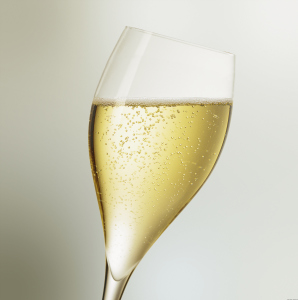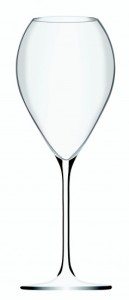There has been a lot of talk lately about what the correct style of glass is for tasting champagne. Coincidentally, when I was on my tour recon visit to Champagne in May 2014, I believe I found the ultimate vessel to tasting perfection!

Philippe Jamesse with a selection of his glasses. Photo: Courtesy Lehmann Glass
It was the unlikeliest of times to find such a perfect glass, in fact I wasn’t even actively looking. We were visiting the wonderful maison of Veuve Fourny, and Charles Fourny had taken us on a magical mystery tour of his vineyards and cellars. After just sitting down in his lounge area to taste his entire range of champagne, he was trying to convince us to lick some chalk he’d picked up from the vineyards so that we would understand what characteristic the chalk gives to chardonnay from the Cote de Blancs, where his vines are situated. Not surprisingly, we respectfully declined.
However we did not decline tasting his beautiful cuvées, and he thus bought out these beautiful glasses, and I was immediately transfixed. More bulbous at the bottom than the standard tulip flute, but narrow at the top, like a normal flute.
I was intrigued to see why these particular glasses were being used. Only filled about a third of way up, after putting my nose to it, I immediately had sensory overload of aromas. As Charles talked us through the technical side of the champagne we were tasting, I was easily able to distinguish all the aromas and nuances he was talking about.
At the end of our most educational of afternoons, I asked Charles about the glasses. He explained that they had been developed by the head sommelier of Les Crayères restaurant, Philippe Jamesse. Les Crayères is a two-Michelin star restaurant in the heart of Reims, so I reasoned the their head sommelier must know a thing or two about ideal glass shapes. Apparently, dissatisfied with the range of tasting flutes available for champagne, in 2008, Philippe Jamesse collaborated with respected French glass-maker, Lehmann Glass to develop his own brand of perfection. So the Philippe Jamesse Prestige range was born.
Naturally, Philippe is a friend of Charles, so Charles gave me his email address should I wish to contact him and find out more about the glasses!
Imagine my delight when I discovered that one of the essays that I had to write for the Vin de Champagne Awards was on the best style of glass to enjoy champagne! Not being able to find much out about the glasses other than what Charles had told me, I decided to contact Philippe Jamesse himself and see if he could explain more about why he developed the glasses. The worse that could happen was that he wouldn’t reply to me, but to my great surprise (and proof again that the Champenois are wonderful people), he did reply, and told me all I need to know.
I have previously written about the importance of the bubbles in champagne (The Importance of Being Bubbly), however, things needed to be a bit more technical for the task at hand.
“Champagne without the bubbles would just be another wine”, says Gérard Liger-Belair, Physicist at University of Reims. So it stands to reason that with more than two million bubbles in a flute of champagne that can make or break the tasting experience, the choice of glass is very important.
 In fact, the effervescence in Champagne is a pleasure trigger to the brain. Before the wine is even tasted, the eye is transfixed by the spiralling ascent of the bubbles to the surface of the glass, finishing with thousands of tiny bursts that release the aroma and promise of the taste in the glass. Then, as they burst on the tongue, the taste buds send the happy signals to the brain. The whole experience of champagne can easily be spoiled by the wrong choice of glass as the shape of the glass directly affects the rise and dispersal of the bubbles in the champagne as well as the release of aroma and flavour.
In fact, the effervescence in Champagne is a pleasure trigger to the brain. Before the wine is even tasted, the eye is transfixed by the spiralling ascent of the bubbles to the surface of the glass, finishing with thousands of tiny bursts that release the aroma and promise of the taste in the glass. Then, as they burst on the tongue, the taste buds send the happy signals to the brain. The whole experience of champagne can easily be spoiled by the wrong choice of glass as the shape of the glass directly affects the rise and dispersal of the bubbles in the champagne as well as the release of aroma and flavour.
Currently, a tall tulip shaped glass is the most preferred shape for enhancing the champagne tasting experience. This shape is wide enough at the bottom to open up the wine and reveal the flavour, narrow enough near the top to concentrate the flavours to the nose and tall enough to allow the bubbles to rise. The glass needs to also be a very fine quality, clear glass to allow the drinker to fully appreciate the spiralling ascent of the bubbles and display the mousse.
“Effervescence is an important aspect of champagne. The chefs de cave take such care and the quality of a champagne is directly related to the quality of the bubbles,” says Jamesse. What he ended up devising were different sized glasses for different champagnes. For complex older champagnes, he felt that a wider glass that curves back in towards the top would be better, but that it should only be filled about half way. The small, slow bubbles of aged champagne can deliver the aromas slowly in the wide part of the glass, and by not filling it too much, there is time for the complexity to develop as the bubbles rise up. The aromas are trapped in the space at the top of the glass, allowing the drinker maximum pleasure.
“With a large breathing surface, all the subtleties of this fragile, yet strong, wine emerge,” M. Jamesse explains.
A similarly shaped glass with a slightly narrower body was developed for non-vintage and younger wines.
These flutes are used now in a large number of champagne houses throughout the region as their tasting flute of choice, and after having had the pleasure of tasting in them, I can fully understand why! Tasting perfection? Absolutely!
UPDATE:
These glasses can now be purchased in Australia! Contact info@thetruffleman.com.au for details

